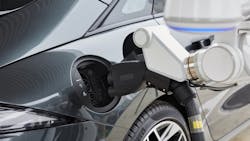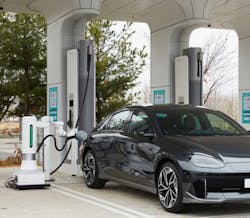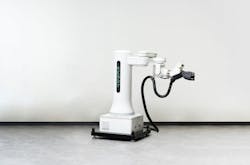AI-Powered EV Charging Robots Planned for Incheon Airport
What you’ll learn:
- Hyundai’s automatic charging robot (ACR) was developed to operate reliably in all environments, regardless of charger location, weather, and potential obstacles.
- The company predicts that robots will support humans with EV charging in the near future, overcoming accessibility issues and inconvenience for some EV drivers.
- Deployment for EV charging robots will first take place at Seoul's Incheon airport.
A key driver for greater electric-vehicle (EV) usage is, of course, convenient charging. Hyundai expects that automatic charging robots will provide some intrinsic advantages to make mobile charging simpler and easier. And, if combined with autonomous parking control systems in the future, they will improve utilization by sequentially charging several parked vehicles.
As part of a demonstration project, Hyundai and the Incheon International Airport Corporation (IIAC) forged a strategic agreement to deploy artificial-intelligence (AI)-based EV automatic charging robots (ACRs) at the airport.
The endeavor leverages Hyundai’s robotics and AI to streamline EV charging and accommodate the expected passenger influx after the “Incheon Airport 4.0 Era” expansion and transformation into an “Aviation AI Innovation Hub.”
ACRs make it possible for a single robot to recharge multiple EVs over the course of hours or days by using a single connector. So, when travelers leave their cars in an airport parking garage and fly to their destination, their parked cars can be recharged without being repositioned and without taking up additional space next to a single charging stall.
How Does the Automatic Charging Robot Work?
The Hyundai ACR for EVs is a one-arm robot capable of plugging a cable into an EV’s charging port and removing it again once charging is complete. The EV—in a demonstration, the company employed a Hyundai IONIQ 6—parks autonomously in an EV charging bay. Once the vehicle is stationary, the ACR communicates with the vehicle to open the charging port, calculating the exact location and angle through a camera mounted inside.
The robot then picks up the charger and fastens it to the vehicle’s charging port, thus starting the charging session. Once charging is complete, the robot removes the charger, returns it to its rightful place, and closes the cover of the vehicle’s charging port.
“The ACR aims to help to make EV charging easier and more convenient, especially in dark environments,’’ said Dong Jin Hyun Head of Robotics Lab, Hyundai Motor Group. “It will also improve accessibility, particularly for people with mobility barriers, as charging cables become thicker and heavier to enable high-speed charging. We will continue developing the ACR for increased safety and more convenience, so that all EV customers can soon benefit from using it at charging stations.”
The Hyundai Group’s Robotics Lab considered diverse variables in developing the ACR, such as the parking location of the vehicle, the shape of the charging port, the weather, potential obstacles and weight of the charging cable.
For a robot to fasten a charger to the charging port securely, software technology is required that can simultaneously calculate these multiple variables. To this end, Hyundai developed an algorithm that applies 3D camera-based AI technology to robots, and control technology based on this application enables robots to accurately handle heavy chargers.
Operational Safety
Given that that most EV chargers are installed outdoors without cover, engineers built an outdoor EV charging station at its R&D center and evaluated performance in various conditions. As a result, the ACR has secured a waterproof and dustproof grade of IP65. IP ratings are used to classify the effectiveness of electrical enclosures in protecting the contained equipment from exposure to liquids and solids, including dirt, oil, and water. IP stands for “Ingress Protection,” while the subsequent two digits are ranked based on the product’s ability to protect against solids (0-6) and liquids (0-9).
Its performance has been improved so that it can be stably operated even in extreme environments. In addition, engineers installed a safety pole with a built-in laser sensor around the robot to prevent possible accidents. It can detect stationary and moving obstacles.
Through this project, Hyundai and IIAC will focus on securing the safety of the ACR, which received Korean certification (KC) last year. It also obtained CE certification by meeting the European Union’s basic safety requirements, ensuring safer use for customers.
The partners plan to accelerate the adoption of electrified vehicles by expanding EV automatic charging services to various domestic and international transportation infrastructures, such as airports, seaports, and railways.


